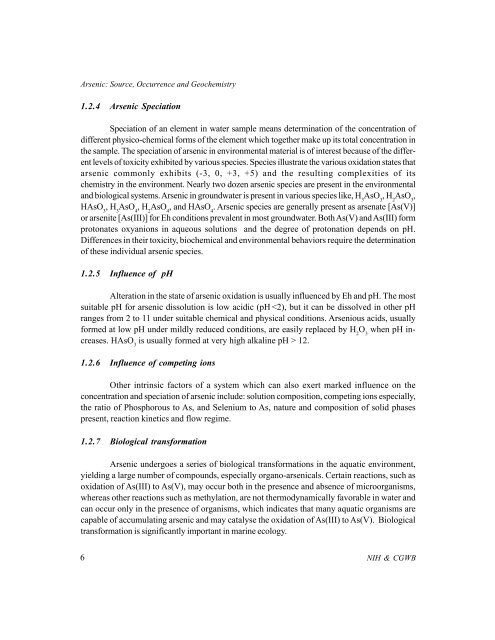Mitigation and Remedy of Groundwater Arsenic Menace in India
Mitigation and Remedy of Groundwater Arsenic Menace in India
Mitigation and Remedy of Groundwater Arsenic Menace in India
You also want an ePaper? Increase the reach of your titles
YUMPU automatically turns print PDFs into web optimized ePapers that Google loves.
<strong>Arsenic</strong>: Source, Occurrence <strong>and</strong> Geochemistry1.2.4 <strong>Arsenic</strong> SpeciationSpeciation <strong>of</strong> an element <strong>in</strong> water sample means determ<strong>in</strong>ation <strong>of</strong> the concentration <strong>of</strong>different physico-chemical forms <strong>of</strong> the element which together make up its total concentration <strong>in</strong>the sample. The speciation <strong>of</strong> arsenic <strong>in</strong> environmental material is <strong>of</strong> <strong>in</strong>terest because <strong>of</strong> the differentlevels <strong>of</strong> toxicity exhibited by various species. Species illustrate the various oxidation states thatarsenic commonly exhibits (-3, 0, +3, +5) <strong>and</strong> the result<strong>in</strong>g complexities <strong>of</strong> itschemistry <strong>in</strong> the environment. Nearly two dozen arsenic species are present <strong>in</strong> the environmental<strong>and</strong> biological systems. <strong>Arsenic</strong> <strong>in</strong> groundwater is present <strong>in</strong> various species like, H 3AsO 3, H 2AsO 3,HAsO 3, H 3AsO 4, H 2AsO 4, <strong>and</strong> HAsO 4. <strong>Arsenic</strong> species are generally present as arsenate [As(V)]or arsenite [As(III)] for Eh conditions prevalent <strong>in</strong> most groundwater. Both As(V) <strong>and</strong> As(III) formprotonates oxyanions <strong>in</strong> aqueous solutions <strong>and</strong> the degree <strong>of</strong> protonation depends on pH.Differences <strong>in</strong> their toxicity, biochemical <strong>and</strong> environmental behaviors require the determ<strong>in</strong>ation<strong>of</strong> these <strong>in</strong>dividual arsenic species.1.2.5 Influence <strong>of</strong> pHAlteration <strong>in</strong> the state <strong>of</strong> arsenic oxidation is usually <strong>in</strong>fluenced by Eh <strong>and</strong> pH. The mostsuitable pH for arsenic dissolution is low acidic (pH 12.1.2.6 Influence <strong>of</strong> compet<strong>in</strong>g ionsOther <strong>in</strong>tr<strong>in</strong>sic factors <strong>of</strong> a system which can also exert marked <strong>in</strong>fluence on theconcentration <strong>and</strong> speciation <strong>of</strong> arsenic <strong>in</strong>clude: solution composition, compet<strong>in</strong>g ions especially,the ratio <strong>of</strong> Phosphorous to As, <strong>and</strong> Selenium to As, nature <strong>and</strong> composition <strong>of</strong> solid phasespresent, reaction k<strong>in</strong>etics <strong>and</strong> flow regime.1.2.7 Biological transformation<strong>Arsenic</strong> undergoes a series <strong>of</strong> biological transformations <strong>in</strong> the aquatic environment,yield<strong>in</strong>g a large number <strong>of</strong> compounds, especially organo-arsenicals. Certa<strong>in</strong> reactions, such asoxidation <strong>of</strong> As(III) to As(V), may occur both <strong>in</strong> the presence <strong>and</strong> absence <strong>of</strong> microorganisms,whereas other reactions such as methylation, are not thermodynamically favorable <strong>in</strong> water <strong>and</strong>can occur only <strong>in</strong> the presence <strong>of</strong> organisms, which <strong>in</strong>dicates that many aquatic organisms arecapable <strong>of</strong> accumulat<strong>in</strong>g arsenic <strong>and</strong> may catalyse the oxidation <strong>of</strong> As(III) to As(V). Biologicaltransformation is significantly important <strong>in</strong> mar<strong>in</strong>e ecology.6NIH & CGWB




